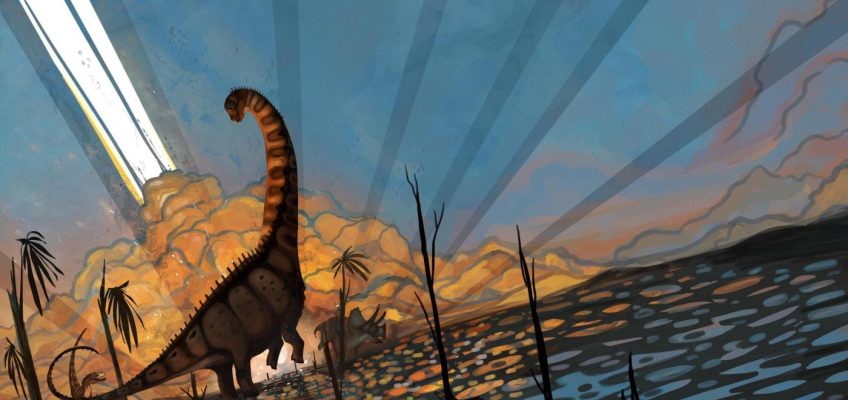By CHRISTINA LARSON, Associated Press
Scientists have long debated whether dinosaurs were in decline before an asteroid smacked the Earth 66 million years ago, causing mass extinction.
New research suggests dinosaur populations were still thriving in North America before the asteroid strike, but it’s only one piece of the global picture, independent experts say.
“Dinosaurs were quite diverse and now we know there were quite distinct communities” roaming around before being abruptly wiped out, said Daniel Peppe, a study co-author and paleontologist at Baylor University.
In this photo provided by researchers, Caitlin Leslie collects paleomagnetic samples in the San Juan Basin of northwestern New Mexico in May 2016. (Daniel J. Peppe via AP)
The latest evidence comes from analyzing a portion of the Kirtland Formation in northern New Mexico that’s been known for around 100 years to contain several interesting dinosaur fossils.
Scientists now say those fossils and the surrounding rocks date from around 400,000 years before the asteroid struck, which is considered a short interval in geologic time. The age was determined by analyzing small particles of volcanic glass within sandstone and by studying the direction of magnetic minerals within mudstone of the rock formation.
The results show “the animals deposited here must have been living close to the end of the Cretaceous,” the last dinosaur era, said Peppe.
In this photo provided by researchers, Daniel Peppe, Utanah Denetclaw, Anne Weil and Blake Gorman collect paleomagnetic samples in the De-Na-Zin Wilderness area of the San Juan Basin in northwestern New Mexico in May 2011. (Steven L. Brusatte via AP)
The findings were published Thursday in the journal Science.
Differences between the dinosaur species found in New Mexico and those found at a site in Montana that were previously dated to the same time frame “run counter to the idea that dinosaurs were in decline,” he said.
The fossils previously found at the New Mexico site include Tyrannosaurus rex, a huge, long-necked dinosaur, and a Triceratops-like horned herbivore.
Related Articles
Pump prices could rise after US, EU hit Russian oil companies with new sanctions and oil spikes
Union Pacific reports 7% higher profits as its CEO makes the case for Norfolk Southern merger
As heat gets more extreme, pregnant farmworkers are increasingly at risk
What Americans think about the environmental impact of AI, according to a new poll
Trump backs off planned surge of federal agents into San Francisco after talking to the mayor
Scientists who weren’t involved in the study cautioned that evidence found at a single location might not point to a broader trend.
“This new evidence about these very late-surviving dinosaurs in New Mexico is very exciting,” said University of Bristol paleontologist Mike Benton, who was not involved in the study. But he added, “This is just one location, not a representation of the complexity of dinosaur faunas at the time all over North America or all over the world.”
Although scientists have found dinosaur fossils on every continent, accurately dating them can be a challenge, said paleontologist and study co-author Andrew Flynn of New Mexico State University. Easily datable material such as carbon doesn’t survive in fossils, so scientists must look for surrounding rocks with precise characteristics that can be used to determine ages.
Further research might help complete the picture of what range of dinosaur species was alive globally on the eve of the asteroid crash, said Flynn.
The Associated Press Health and Science Department receives support from the Howard Hughes Medical Institute’s Department of Science Education and the Robert Wood Johnson Foundation. The AP is solely responsible for all content.


Leave a Reply